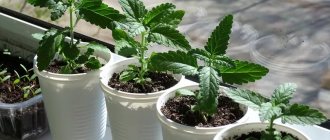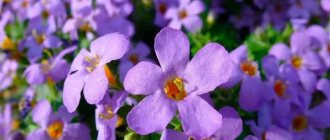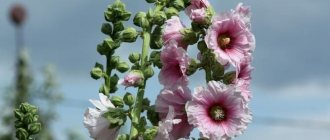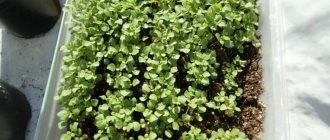The best ornamental varieties of saxifrage plants
Indoor saxifrage is perfect for beginning flower growers.
The undemanding nature of most species of this plant allows it to be placed in northern rooms and rooms with moderate access to sunlight. Bright lighting can make the plant look pale and cause disease.
This flower prefers dry and cool environments, it has massive leaves and generously produces tendrils. Saxifraga is a bush, the species of which like sparse watering, soil with plenty of sand, and look good next to petunias.
During the spring-autumn period, acceptable temperature values for saxifrage range from 20 to 25°C. In winter, the plant will suit 12-15°C, its subspecies with variegated leaves will need from 15 to 18°C.
Lighting
The flower can be planted near the shady sides of the window; the best option is the western and eastern sides of the house. Northern sides are also allowed, but when placed on the southern side, it will be necessary to provide the saxifrage with protection from direct rays of the sun.
Direct sunlight is not allowed
Fresh air stimulates its growth, which is why it is often placed on a summer balcony. Intense lighting is harmful, but lack of sunlight can also cause fading. In an open garden, the plant is planted in the shade.
Use settled water at room temperature. The soil should not be oversaturated with moisture, as this will lead to rotting of the roots. Drying out the soil is also unacceptable.
From the beginning of spring to the end of autumn, the house plant is watered no earlier than the top layer of soil has dried to a thickness of 2-3 cm, this is about 2 times a week. When located on open ground, precipitation should be taken into account.
For the winter period, the watering schedule is once every 8-12 days. Water should not accumulate in leaf rosettes; this can also contribute to rotting, and therefore the best method of watering is a tray. It should feed the pot only until the soil is completely moistened.
Spraying
The saxifrage should be sprayed with the same water as for watering. Infrequent spraying is carried out in spring and summer. If the air in the apartment is dry, it is carried out occasionally in winter.
Humidity
In winter, it is not recommended to keep the plant near radiators or heating devices, but to increase air humidity, you can dry wet things on adjacent radiators.
Despite its love for moisture, saxifrage thrives in dry climates, while frequent spraying can be harmful.
Additional Information. Humidity is increased by containing expanded clay, moss or pebbles in the tray; another way to humidify the room is to place vessels with water near the pot.
This flower is adapted to obtain useful substances from scarce mountainous areas and rocks, which is why ordinary soil is not suitable for it. Ideal for saxifrage would be a combination of garden or greenhouse soil, crushed gravel, lime, peat and sand.
All this is enough in the same quantity with the exception of gravel, a handful of which is enough for a volume of 5 liters.
Top dressing
Soil enrichment is carried out in summer, winter and spring with a fertilizer solution diluted in water.
In winter, fertilizing is done once every one and a half to two months, the rest of the time every two weeks.
Note! With a lack of nutrients, the sprouts spread chaotically, and the leaf bases lengthen. An excess increases the risk of fungal diseases.
In winter, the flower remains dormant.
The low activity of saxifrage in winter is explained by its adaptability to weather conditions.
Control of humidity, temperature and fertilizers, the conditions of which are common to most species, should be observed.
Those of them that can grow outside the house and are at the same time in an open garden do not need to be watered and fertilized in winter. Before the onset of cold weather and snowfalls, moderate mulching is necessary; the saxifrage is covered with grass.
These flowers are very diverse in shape, color and size, providing a wide choice for enthusiastic gardeners. For example, the shady saxifrage produces small, soft pink inflorescences, while the opposite-leaved flowers are deep pink and large, becoming purple over time.
Types of flowers
Saxifragas bloom in colors such as:
- white,
- red,
- lilac,
- purple,
- yellow,
- pink.
Additional information: certain varieties gradually change shade. There are also two-color and variegated flowers; the inflorescences of some species are painted with colored spots.
Among the saxifrage flowers, flowers of five short, oblong-rounded petals predominate.
There are also four-petalled ones, but this is a great rarity not inherent in any particular variety. Common standard forms on a smaller scale are bells and complex designs such as the wicker type.
Flowering begins in late spring and early summer; some weather-sensitive varieties may bloom in July.
The formation of inflorescences begins at the end of spring of the second year; they grow in the form of loose panicles. The first time there may be a small number of flowers.
Some varieties bloom in the fall, but generally the flowering time is from three weeks to the end of summer. After it, the flower stalks remain sticking out, so they are usually cut off.
At this time, saxifrage does not need any additional care beyond the usual spring-summer care. For more orderly flowering, panicles are sometimes trimmed.
Cultivated varieties of saxifrage can improve the appearance of any area. Ideal for growing in flower beds, in flowerpots, as well as for organizing organized flower beds and large stones. To grow saxifrage in the garden, choose varieties of soddy saxifrage Arends. The best varieties of Arends saxifrage include:
- Variety “Purpurmontel” - plant height does not exceed 20-25 cm. The flowers are medium bright, purple-pink in color, forming a very dense green carpet. Blooms in early June. The “Purpurmontel” variety is not afraid of frost; when grown as a perennial plant, it does not require shelter.
- Variety “Snow Carpet” - plant height does not exceed 15 cm. The flowers are medium bright, white, forming a dense green carpet. Blooms in mid-May. The “Snow Carpet” variety forms a dense cushion up to 3-5 cm in height. Ideal for decorating rocky areas.
- Variety "Flora Carpet" - plant height no more than 20 cm. The flowers are medium-sized, white-pink. Blooms beautifully on alpine hills. Blooms in early June. The "Flora Carpet" variety forms a dense cushion up to 3-5 cm in height. The only variety that prefers to grow on the sunny side of the site
- Variety “Flamingo” - plant height no more than 20 cm. The flowers are medium-sized, white-pink. Planted in small groups in garden plots and flower beds. Blooms in early June.
The Flamingo variety is most often grown as a perennial plant. Winter-hardy variety.
This rhizomatous plant, which can grow up to 70 cm high, is characterized by:
- creeping stems;
- branched root system;
- pronounced basal rosette;
- fleshy and leathery leaves.
Saxifraga Arends at home
The described plant has several subspecies, which differ mainly only in the color palette. All can boast of resistance to cold and ease of care. Among the most popular varieties are:
- Flamingo. According to the name, it has a soft pink bud color;
- White Carpet. Small inflorescences with snow-white bells bloom above the dark green shoots. Maximum diameter - 1 cm;
- saxifrage Purple carpet (Pink carpet, Purple Carpet). Probably the most beautiful and noble of those listed. Saxifraga purpurea has an aristocratic burgundy color with a yellow core;
- Floral Carpet is a very popular and beautiful plant, which is distinguished by its delicate white and pink shades.
Purple Carpet
Saxifraga Flower carpet covers the ground with graceful petals. Therefore, it is not surprising that all subspecies are very often used for exterior design, especially landscapes.
For your information! On the Internet you can find another name - Anders' saxifrage, but this is a mistake. In the botanical encyclopedia, the plant appears as Arends' saxifrage and has no other names.
Despite its praised unpretentiousness and simplicity, saxifrage still requires some attention for abundant flowering. Several recommendations on how to care for the vaunted plant.
We suggest you familiarize yourself with How to grow melon in open ground
Arends' saxifrage feels great both under aggressive sun and in partial shade. However, we must remember that keeping a plant in the shade for a long time can have a detrimental effect on its condition.
Important! It all depends on the air temperature. If it is above 20°C, it is advisable to provide the plant with a more shady place. Heat causes the rapid development of parasites and diseases, which has a very negative effect on the appearance of the plant.
Soil and fertilizers
Arendsa prefers light soils:
- loose build;
- low connectivity;
- easy workability.
Saxifraga in macro photography
One of the main factors when choosing soil is the presence of limestone, which has a very beneficial effect on the condition of the plant, fertility and good drainage.
Important! Superphosphate and bone meal are excellent fertilizers for saxifrage.
Although soil fertility is one of the main factors, you should not get carried away with fertilizers. The abundance of nutrients has an impact and is detrimental. Everything is good in moderation.
Watering and humidity
Saxifraga loves water very much. Watering should be done in moderation, since stagnant moisture destroys the roots of the plant. When planting, it is worth organizing in advance the drainage of excess water from the root system, ensuring drainage.
Regarding the temperature regime, saxifrage also has its own requirements. This noble plant does not survive at temperatures above 20°C. Surviving the winter is not a problem, but the heat can provoke many serious illnesses and the proliferation of pests.
Description and varieties
Saxifraga (“break-grass”) is a low-growing perennial plant, although there are annuals and biennials, the appearance is very diverse.
The appearance directly depends on the species/cultivar: flowers and leaves are different in shape, color, texture; in the wild it grows on rocky slopes, rocks, and is found in meadows.
Decorators value the variety of leaves and flowers, the ability to hide the ground with a carpet pattern, and to take root in depleted soil.
Decorative varieties are conventionally divided into several groups:
- Purple flowers.
- Silver saxifrage.
- Mossy plants (evergreens).
They all grow in cushion-shaped groups, the main flowering season is summer. They are distinguished by the color and texture of flowers and leaves. The first group has purple flowers with all sorts of shades, the second and third have a wide range of flowers: white, yellow, greenish, pink and many others.
Types of saxifrage:
- Braided (also: spider, beard, Venus hair). Grow in hanging pots, on a hill, in a winter garden, apartment, greenhouse. The main difference from its counterparts is the red hanging lashes (stems, stolons, mustaches), sometimes reaching a meter in length. Reproduces using daughter rosettes.
- Paniculata. Planted in stone crevices in rock gardens (north or eastern sides). Loves humus and frequent watering. In summer they propagate by dividing the rhizomes.
- Cesium. Only experienced gardeners can grow it, since it is demanding on soil and care.
- “Hard-leaved” and “Opposite-leaved”: the soil must contain calcium. Propagated by dividing rhizomes and cuttings.
- Tupolis (cotyledon): the soil should contain little limestone, likes sunny areas. Reproduction: seeds, daughter rosettes.
- Hawkleaf: planted on an inclined surface, propagated by seeds.
- Arendsa: not afraid of shade, illuminated areas, after flowering the bush is divided or propagated by cuttings.
Popular varieties:
- Bagryantsevaya.
- Flamingo.
- Purple robe.
- Bolotnaya.
- Grainy.
- Black ruby.
Black ruby
Bolotnaya
Purple Robe
Flamingo
Bagryantsevaya
Here is a small fraction of the names from the entire variety of saxifrage. After talking on gardening forums, every beginner will discover the magnificence of many plant varieties, suited to any soil and terrain.
How to grow seedlings from saxifrage seeds
From saxifrage seeds, seedlings are grown in closed ground. Grown seedlings are planted in open ground in early July. Seedlings planted in open ground will begin to bloom only after a year. Let's look at the step-by-step instructions for pre-sowing preparation of seeds and soil.
The optimal time for sowing saxifrage seeds is late March - early April
Saxifraga seeds are very small, so before planting, the seeds should be mixed with clean sand, which will help distribute the seeds evenly on the surface of the seedling box. Before you start sowing seeds, you need to perform several activities:
- Seed preparation. Before sowing the seeds in planting containers, they should be stratified: the seeds are placed in a small bowl and sprinkled with a thin layer of sand and sent to the refrigerator for 3 weeks. Stratification of saxifrage seeds is carried out to improve germination and accelerate germination
- Preparing the soil for sowing stratified seeds in a seedling container: The germination of saxifrage seeds depends not only on stratification, but also on the water and air permeability of the soil. It is best to plant seedlings in a vermicompost soil substrate.
- Sowing seeds in a seedling container or peat tablets. " Stratified seeds are evenly distributed along with sand over the surface of the moist soil or placed 2-3 pieces in peat tablets and lightly sprayed with warm water. The container with seeds (peat tablets) is covered with film and placed on the warmest and brightest windowsill. As soon as the shoots appear, the film is removed from the container. The seedlings will sprout in 10-15 days.
- Care. No watering is required until seedlings emerge. The main care is to remove accumulated condensation on the surface of the film.
- Picking. As soon as the seedlings have 2 leaves, they are planted in separate containers - pots, cups for further development of roots and a larger feeding area.
- Preparing the substrate and planting young shoots in cups.
For pickled plants, choose a loose soil mixture, which is mixed with sand and peat in equal parts. The cups are filled three-quarters full with prepared soil and compacted lightly. Then use your finger to form a depression in the soil and begin replanting the seedlings. The saxifrage sprouts should be removed together with a lump of earth using a spoon. Before plunging the seedlings into the holes, it is recommended to shake off a little clod of earth and pinch the longest root for further development of the lateral roots. Growing saxifrage from seeds - Caring for pickled saxifrage seedlings. After picking, the seedlings are watered in moderate quantities with warm water. Cups with seedlings are removed for 48 hours away from sunlight.
How to care for saxifrage seedlings at home
Correct agricultural technology for growing seedlings is one of the most important and main conditions for obtaining good and strong seedlings. Plants at all stages (from sowing to planting in a permanent place) need favorable conditions and care. Thanks to this, in the future you will get elegant and airy plants of miniature size with beautiful flowering.
After stratification and before the emergence of saxifrage shoots, it is necessary to care for it as follows:
- Seeds need to be germinated on a light windowsill.
- Optimal temperature: 20-22 degrees Celsius.
- While waiting for germination, the container with seeds must be covered to maintain greenhouse conditions! This can be cling film, a lid of a suitable size, or glass. The main thing is that the material allows light to pass through!
- Containers with seeds should be ventilated daily (preferably in the morning and evening) to prevent mold or mold/rotting of the seeds. Simply remove the cover for half an hour and wipe the condensation off the covering material with a dry cloth.
- As a rule, there is no need to water the soil during the period of seedling germination; the soil does not have time to dry out. However, if for some reason the soil begins to dry out intensively, it needs to be slightly moistened with a spray bottle. The surface of the earth must not be allowed to dry out, otherwise the seeds will dry out and never germinate. There is simply no need to water if the soil is wet.
By the way! Seeds germinate in about 1-2 weeks.
After the emergence of seedlings, caring for saxifrage seedlings at home takes on the following character:
- When you see shoots, you need to gradually remove the cover. What do you mean, gradually? That is, for several days you need to increase the time the seedlings are left without a lid/film. On the 1st day, the cover is removed for 2 hours (morning and evening), on the 2nd day - for 4 hours, on the 3rd day - removed for the whole day (cover it back at night), on the 4th - removed completely.
- Regularly monitor the soil moisture with seedlings. It is important to maintain very moderate soil moisture on a regular basis. When the top layer dries, watering is done with clean and settled water at room temperature. After 2-3 hours, you need to drain the water that has poured into the pan.
Note! Saxifraga does not like waterlogged soil (even at the stage of growing seedlings!). Therefore, you need to water very carefully. Excess moisture can cause rotting of the root system and other unpleasant phenomena.
- When the saxifraga seedlings have 2 true leaves, it is necessary to pick the saxifrage seedlings. For replanting, you need to use 250 ml cups with drainage holes, but you can use the same soil. You need to place 1 plant in one container. A couple of hours before transplanting, you need to water the seedlings, and then very carefully remove one plant at a time, conveniently removing it with a wooden stick (the roots should remain intact, with soil on the roots). Then the seedling needs to be placed in a hole in the center of the cup, the roots should lie flat, without bending.
- After picking, for the first 3-4 days the plants should be placed in a room with diffused sunlight; they should be protected from direct rays of the sun. Direct rays will cause stress in already anxious plants, slow down rooting, or even cause leaf burn.
Use in landscape design
Saxifragas are characterized as drought-resistant plants, therefore, for landscape design in a personal plot, saxifrages are planted in dry areas. They look great and grow in rocky areas, especially where unsightly areas need to be covered. "
Experts identify several mistakes that gardeners often make when growing saxifrage:
- Grow in direct sunlight.
- Seeds for seedlings are not subject to stratification.
- The depth of planting seeds in the soil is more than 2 cm.
- Application of mineral fertilizers during flowering.
Saxifragas look perfect on alpine slides.
Saxifraga Arends is very often used in landscape design for several reasons:
- unpretentiousness;
- the ability to grow where most plants die;
- beautiful ensemble with other plants.
Seedlings are used to decorate rock gardens. It looks harmonious with artificial embankments, therefore it is used as an element of eco-design. The juicy green tone of the leaf blades in an ensemble with contrasting inflorescences favorably fills the territory of an empty garden.
For your information! Saxifraga Purpurmantel is another elegant variety for exterior solutions. It looks advantageous not only in the garden, but also as a decoration for balconies and terraces.
Saxifraga care
The main rule for a gardener in caring for a plant is knowledge of the chosen species and the features of caring for it. Do not forget that some saxifrages love moisture and shade, others love the sun and a certain soil composition.
In order for the plant to look healthy and provide timely pleasure with beautiful flowers, the gardener is strongly recommended to study all the information on the specifically chosen species:
- The plant dies when exposed to direct sunlight, and the temperature should be: 20-25°C for summer, 12-18°C for winter.
- In spring and summer, it is recommended to spray saxifrage with the same water as for irrigation.
- After flowering, to maintain a decorative appearance, all remnants of flowers and stems are removed.
- Before winter, the bushes are covered with spruce branches and dry leaves.
When growing in a garden, care begins much earlier than the appearance of the plant itself: it is necessary to build a hill with drainage in advance, then properly grow, plant, and care for it.
Watering
Water is used that is settled, soft, and warm. Rainwater is perfect.
From spring until autumn, water in a moderate mode (the top layer of soil dries out - add water). In winter, only indoor saxifrages are occasionally irrigated so that the earthen ball does not dry out.
Fertilizers
Mineral fertilizers are added to water for irrigation. Various organic fertilizers (bone meal) and superphosphate are suitable for saxifrage. It is not recommended to use nitrogen fertilizers.
Top dressing
They feed all year round only if the plant lives in an apartment or winter garden. For feeding, take a liquid consistency or fertilizer solution.
Refill quantity:
- In spring, summer - every 14 days.
- In autumn - every 45 days.
- In winter - every 60 days.
Stop watering and feeding street crops before frosts.
Transfer
Reasons for transplantation:
- The plant has “grown” and requires more space.
- The composition of the soil has deteriorated.
- The plant lived in one place for more than six years.
- Part of the group is infected with some disease.
Composition of the substrate for replanting:
- Acidity: approximately 6 (pH), drainage is placed at the bottom of the hole/pot.
- Land – 1 part.
- Turf – 2 parts.
- Sand – ½ part.
You can prepare the above mixture by adding 1 part each of compost and peat. Mix all ingredients thoroughly.
Diseases and pests
It rarely gets sick, but if you do not care for it properly and do not carry out preventive measures, then there is a risk of losing a large amount of saxifrage.
Its main “enemies” are:
- Fungal infection.
- Spider mite.
- Mealybugs.
- Aphids: The insect comes in white, green and brown colors.
- “Powdery mildew” - with this disease, the leaves are powdered with a white coating.
- “Rust” appears as brown or yellowish spots on the leaves.
- Incorrect watering, lighting, temperature.
If, without any visible signs of pests, the plant suddenly stops growing, turns pale (too much moisture), becomes covered with dry spots (sunburn), and the leaves become spotted - re-read the information about proper care for this variety of saxifrage.
Reproduction and planting
Before planting seedlings, lime, gravel, sand and high-moor peat should be added to the soil. Seedlings are planted in open ground using the transshipment method. Flower growers recommend not watering seedlings in cups 2-3 days before transshipment so that the earthen ball with seedlings can be easily removed. Seedlings are planted in moist soil.
Saxifraga seedlings are planted at a distance of no more than 20 cm, which will allow you to obtain a continuous and dense flower carpet. Seedlings are planted only on the shady side of the site. Water the seedlings in the morning and evening as the soil dries out. Loosening and weeding are carried out as necessary. The plants are fed once a month strictly with mineral fertilizers. Fertilizer is applied along with water during irrigation.
In the table we consider the main types of mineral fertilizers, as well as the timing and rates of their application.
| Fertilizers | Application period | Application rates g/m2 | Basic substances |
| Potassium | Autumn until spring planting. At the end of spring and summer | 15-20 | Potassium sulfate and carbonate |
| Phosphorus | 30-40 | Superphosphate Phosphorus flour | |
| Nitrogen | Spring, autumn | 30-40 | Ammonium sulfate |
| 25-30 | Ammonium nitrate |
The optimal temperature for saxifrage flowering is 20°C
Saxifraga is the most resistant plant to diseases and pests; it is practically not affected by pests and diseases. With improper care, in rare cases, plants are affected by diseases such as septoria. You can rid the plant of the disease with a weak solution of copper sulfate. As a preventative measure, regularly inspect the plantings and remove affected buds, as well as maintain moderate watering.
Pests include green aphids. The pest must be controlled using Bordeaux mixture. As a preventative measure, carry out regular inspection and remove affected leaves. In the table we consider the main reasons for the appearance of septoria and aphids on saxifrage plantings.
| Fertilizer name | Fertilizer application rate | Application period |
| Superphosphate | 5 g per well | When planting seedlings in open ground |
| Nitroammofoska | 5 g per 1 liter of water | 2 weeks after planting and at the budding stage |
| Azofoska | 5 g per 1 liter of water | During the period of active growth of green mass of flowers |
When planting and propagating Arends saxifrage, there are no special differences from other plants. You can grow flowers both on rocky, depleted soil and on fertile, well-fertilized soil.
We invite you to familiarize yourself with Melon in syrup without sterilization (for the winter) - a step-by-step recipe with photos on Povar.ru
Note! Excessive soil moisture leads to rotting of Arends' saxifrage.
It can grow both in the shade and in direct sun. The plant has no special whims, but the only thing that needs to be done regularly is watering.
In order for this amazing plant to bloom and delight its owners for a long time, it is necessary to follow certain rules when growing it from seeds.
Saxifraga White
Before sowing seeds, they need to be stratified. This is done for better germination. This procedure is performed in the following way:
- Mix the seeds with sand.
- Place the mixture in the refrigerator for two to three weeks.
Then you need to plant the seeds into seedlings. The next steps look like this:
- Prepare containers with a special mixture.
- Scald the soil with boiling water.
- Spread the seeds mixed with sand over the surface.
- There is no need to spray and cover the crops with film; there is no need to sprinkle with soil.
If all these steps are done correctly, then within 7-10 days the Arends saxifrage will produce its first shoots. Afterwards, stronger specimens with small leaves are dropped into peat pots.
To grow a plant in this way, various factors must be taken into account. However, the method is quite easy and fast. To get good bushes, it is recommended:
- Cut off rooted shoots or shoots with aerial roots.
- Transplant to a new place with a lump of earth.
Note! Arends saxifrage shoots do not tolerate cold.
Shoots that are longer than 5 cm are later cut and divided into several parts. The plant must be rooted in water or peat soil, but this must be done indoors.
Planting Arends saxifrage in open ground is very easy. You need to choose the right place for her.
- if this is an area with abundant sunlight, then it is important to regularly moisturize;
- in the case of partial shade, no special care is required.
Caring for saxifrage
It is customary to plant the plant in open ground in early June, when the seedlings are already sufficiently strong. After planting, Arends' saxifrage initially grows shoots, after which it blooms only after a year. The main thing is to choose the right soil, which will provide the plant with all the necessary nutrients.
Planting saxifrage seedlings in open ground or a pot
You can plant saxifrage seedlings in open ground or in a pot for growing on a windowsill (or balcony). They are planted in open ground after the onset of stable heat (approximately the second half of May).
Favorable conditions for this low-growing plant are areas with rocky, alkaline soil with low or moderate fertility.
The growing area should be bright, but not in direct sunlight!
Before planting, it is recommended to prepare the site: add chalk or lime, sand, gravel, peat to the soil (if the soil is not loose enough). It is advisable to prepare the location in a couple of weeks.
Planting saxifrage seedlings in open ground or pots is done by transshipment. That is, a whole lump of earth together with the plant is transplanted into a hole in a new place, covered with earth, and watered abundantly. A couple of hours before transplanting, you need to water the seedlings so that the earthen ball retains its integrity. In open ground, the distance between plants is 20 centimeters from each other.
When transplanting into a pot, you need to make very good drainage (necessarily holes, a drainage layer 5-7 cm thick, expanded clay or broken brick).
After transplantation, you need to place the plants on the western or eastern windowsill (balcony), but it is not recommended to place them on the southern ones. Direct sunlight will negatively affect the decorative appearance of the plant.
Reproduction and planting
Saxifraga, the planting and care of which is accessible to a gardener of any skill level, reproduces according to certain rules.
The usual vegetative method may not give results. The saxifrage plant reproduces through cuttings, seeds, layering and division of rosettes. All these methods are practiced either in early spring or in November. In this case, the seeds will germinate in the spring. Other methods should be planted in the fall, ensuring that the flowers have time to send out roots before frost and snow.
Germination of seeds
Most often, saxifrage for planting and care in open ground, as well as for indoor conditions, is sown indoors. In spring, the sprouts can be planted in the garden.
In the home version, the seeds are stratified by mixing them with sand and placing the container in the refrigerator for a period of a couple of weeks. The soil is slightly compacted, covered with the contents of the seed container and watered.
Then the container should be covered - the greenhouse effect stimulates seedlings. They will appear in 10 days; after they have 4 leaves, the sprouts are planted separately. They should receive moderate watering for the first few days.
Indoor seeding is more convenient and efficient
When planting in an outdoor garden, the next step is to prepare the soil. It should only be done when it is warm enough. For the future flower bed, apply a layer of soil suitable for saxifrage from 20 to 30 cm in thickness. The planted seedlings must be pre-watered again, and the soil is loosened at the planting points, where recesses are also made for the seedlings with an interval of 20 cm between them. After planting, these places are compacted a little; their first watering is carried out after about a week.
When sowing directly into the garden, the seed should be disinfected in potassium permanganate, strongly diluted with water, for a couple of days. Other fungicides will also work. The disinfected seeds are dried, sand is added to them, then the special soil already applied to ordinary soil is furrowed 1.5 cm. The seeds are planted, covered and watered.
Note! This is not the most effective method. If nothing has sprouted within a month after spring sowing, you can plant or sow other plants.
Rooting cuttings
The time for taking cuttings is late July. They should be from 7 to 15 cm long.
The shoot is cut below the node in flowers from two years old using a sharp blade. Its lower leaves are removed, and the cut is immersed in a diluted phytohormone for a few seconds.
The planting container is filled with wet sand. Before planting, treatment with charcoal powder is recommended. When the seedlings take root, they are planted separately or left in the sand until spring planting in the garden. In this case, tolerably cool temperatures and low lighting will be required.
Dividing bushes
This is the most common method. The sections of the plant that appear in the spring branching are separated in July, along with their roots, from the main bush by a sharp blade. The cuts are treated with wood ash, the rosette with fungicides, then the young saxifrage is planted in suitable soil. There should be at least 20 cm of free area around it. Planting in the garden should be done no earlier than spring. The first flowers can be expected next season.
Layerings
Picture 11 Layers serve to spread the cover of the bush
Note! The second most popular method of propagation is layering - this is the simplest method.
Under the new young shoots that have grown further away, in July small depressions are made in the ground, watered, after which the sprout is fixed there with a light handful of soil.
It should be watered on a standard schedule without overwatering in case of rainfall in garden conditions. The roots are produced in the fall, but the flower does not separate until spring. The cut is treated with wood ash, then the saxifrage from the layering is transplanted to its new place.
Possible problems in growing saxifrage
The plant is not too demanding to care for and is very resistant to various types of pests. But improper watering, excessive fertilizers and too high temperatures can cause diseases.
Arendsa: diseases and pests
Pests
The most common pests of Arends saxifrage are:
- spider mite, which appears exclusively during drought. Signs of a mite include yellowed leaves and clumps entangled in whitish cobwebs;
- green aphids appear as a sticky black coating on stems and leaves and are very dangerous for saxifrage;
- scale insects are pests that cover the entire plant and eat it. They can be collected manually, or you can use special solutions to destroy them;
- thrips are pests that also eat the plant. Signs of this pest are white spots on the leaves.
In the fight against parasites, it is worth using insecticides.
Diseases
Arends' saxifrage is rarely susceptible to disease, but if not properly cared for, this can still happen. Although the plant loves humidity, this can also become a big problem. Excessive moisture can lead to the development of various fungi and rot, which leads to the complete death of the plant. This is the result of large stagnation of water in soil that has poor drainage. To save a plant that has just begun to rot, you need to dig it up with its roots and trim off the rotten areas.
Important! Various fungi can develop on the plant, also as a result of excessive humidity. For example, rust, which turns the saxifrage stem red. To destroy the fungus, various solutions of soap and copper sulfate are used.
It is impossible to describe one single tip for growing a plant. Each type requires an individual approach. In gardens, gardeners have domestic saxifragas, which practically do not require strict care. Such varieties are resistant to winter.
Two main conditions when planting saxifrage: fertile, moist soil and a light location of the plant. Types of crops that require stricter control usually grow in the shade and are afraid of direct sunlight.
It will be interesting to read: Cissus: description of a houseplant
Some species like dry soil with a lot of humus, others prefer fertile and moist soil. The blunt-leaved species prefers an acidic soil environment. Long-leaved saxifrage requires lime in the soil. Paniculata prefers neutral acidity of the soil and a large amount of calcium in it.
We suggest you familiarize yourself with what varieties of radishes can be planted before winter
The soil near the flowers should be moist, but without stagnation of liquid in it. It is necessary to spray the leaves on hot days. Air humidity for growing should be high. During the entire flowering season, saxifrage needs to be fed twice. Complex fertilizers with minerals are suitable for this.
Do not allow other plant debris to come into contact with the plant. This has a bad effect on the development of culture.
Gardeners mulch using crushed stone. This allows you to protect the saxifrage itself from overheating, and the rhizome of the plant from rotting.
Reproduction
There are several ways to propagate saxifrage.
- Division. In August, you can propagate saxifrage by dividing the bush. It is removed from the ground and divided into several parts, which are planted separately.
- Cuttings. At the beginning of summer, some plant species produce shoots. They can be used as cuttings. The branches must be at least ten centimeters long. Saxifraga is planted in fertile soil with peat. During the summer season, the cuttings will take root. For the winter, the young bush is covered from frost. Leaves are used for this. Some people transplant the bushes into pots and take them home. The following summer they are transplanted back into the garden and they begin to bloom.
- Independent reproduction in saxifrage occurs through layering. The shoots touch the ground, take root and separate from the mother bush.
Growing saxifrage from seeds
To propagate saxifrage in this way, you only need fresh seeds. They are planted in the soil at the beginning of winter. You can plant it in a pot, but be sure to put it in a cold room.
The seeds are poured onto the soil and sprinkled with a little soil and sand. Cover the whole thing with film and leave it in the refrigerator for three weeks. There are species that need to be left in such conditions for a longer time.
Once the stratification has passed, the container is placed in a bright room. After a couple of weeks, the seeds will sprout. Two or three leaves appear. During this period, each bush needs to be transplanted into separate small containers.
At the end of spring, seedlings must be accustomed to natural conditions. The hardening method is suitable for this. Boxes and pots are taken outside. In June it is already possible to plant bushes in open soil. The first year of life the plant will get used to, feed and gain height. Saxifragas will be able to bloom only after a year.
Those seeds that do not germinate are left in the pot and the soil is constantly kept moist. There are species that take about a year to emerge. If you buy Arends saxifrage in the store, the seed planting method will be easier. The seeds are planted in March in seedling boxes. You can sow the seeds in open soil at the end of spring.
garden plants
The best condition for the active growth and development of saxifrage is to grow the plant in the garden. You can use gardens in the form of slides, rocky flower beds. In such an atmosphere, the culture will feel comfortable and delight flower growers with its blooms.
Saxifraga can be planted separately. They look decorative not only with stones, but also with retaining walls.
Among the neighbors for the flower, you can select such crops as sedum, phlox, which grow in the form of a carpet, low-sized bells, and dwarf irises.
Another article described: Bemeria: description and care at home
This bush is resistant to diseases and parasites, but the health of the flower may deteriorate due to disruption of the living conditions and vital activity of pests.
Yellow, dried out and deformed lower leaves indicate old age of the plant, in which case it is time to carry out the renewal procedure.
The absence of branching and layering may indicate a lack of nutrients, which can be easily replenished with a quick-acting liquid fertilizer or a capsule of universal fertilizer placed 3-5 cm deep into the soil.
Fading and looseness of the bush can be observed both with a lack of lighting and with overheating - in this case, it is necessary to urgently change the location of the pot.
Additional Information. For preventive purposes, it is useful to care for the leaves by wiping them with warm water to remove dust once a month.
Frequent illnesses
- Excess moisture can lead to rotting of the root system. When wilting and blackening, the plant should be inspected for rotting roots. They are removed along with the affected leaves. You can try to root the preserved petioles in a temporary substrate of sand with pieces of sphagnum in a 50/50 ratio. A greenhouse effect is created, the pot is placed in a place with the recommended temperature and sufficient lighting. Saxifraga can produce its first sprout within a month.
- Rust infection occurs through fungal spores carried by insects; granular spots of the corresponding color indicate that the water balance is disturbed. Rust is treated by removing the affected areas and treating with a fungicide, which is repeated again after 10 days. In this case, the plant should be protected from the presence of conifers.
- Powdery mildew is a consequence of a fungus; white spots on the lower leaves are replaced by drops of moisture as the spores mature. This stops the flower's growth and makes it vulnerable to cold. Damaged sprouts should be separated and burned, and the plant itself should be treated with fungicides such as quadris or skor.
Main parasites
- Spider mite infestation manifests itself in dry saxifrage. The leaves turn yellow, and a light cobweb appears at their bases. This is treated by removing and burning the affected areas, then applying an insecticide.
- The sticky white coating on the leaves is the secretions of aphids; the flower is washed with soap and regularly sprayed with a settled mixture of garlic, pyrethrum, onion peels and pepper.
- The inflorescences and foliage of the plant attract scale insects; they multiply quickly when the flower lacks moisture. Symptoms include sugary discharge. Scale insects are treated by treating the affected areas with a mixture of 12 g of soap per liter of water once a week and collecting the pests by hand. In the future, saxifrage must be treated with biotlin or confidor.
Additional Information. In addition to these pests, the flower can become infected with thrips and nematodes.
The beauty of the plant deteriorates if the conditions during cultivation are not observed, which entails uneven stems and bald spots in the usually dense branching cover. Open ground can attract birds and mice to the flower.
In general, growing saxifrage is not difficult, and a wide selection of species opens up good scope for decorating a room or garden plot. The plant is quite suitable for inexperienced gardeners.
Reproduction of saxifrage
Propagation by seeds
Every plant has its own secret, saxifrage is no exception. Its main secret is cold treatment of seeds, which guarantees good germination.
Starting in April, gardeners begin the procedure for processing seeds for planting:
- The moist soil is placed in a flat container, and the seeds are laid on top and left in the refrigerator for 14-20 days.
- The seedlings are moved from the refrigerator to the windowsill of a well-lit window and covered with film (the temperature inside the greenhouse should be +18 - +20 degrees), small black seeds germinate in 7-8 days.
- After the first shoots, the film is lifted for air circulation.
- It is necessary to wait for strong leaves and move the seedlings into large boxes.
When propagated by seeds, saxifrage blooms for the first time in the second year.
Propagation by cuttings
The procedure is done in any season except winter:
- A single rosette of leaves is cut off at the base of the stem, the lower leaves are removed and placed in a container with sand.
- Leave for rooting in a cool place where there are no drafts;
- Rooted cuttings are transplanted into a pot, and after a few weeks - outside.
The cuttings are planted in non-acidic drainage soil; you can use sterilized garden soil.
Reproduction by dividing the bush
It is necessary to wait until the plant has completely bloomed:
- Prepare holes (size and depth depend on the size of the saxifrage for division). Remove all the soil from the hole, mix with sand, compost, fine limestone, and place drainage on the bottom.
- In order for the bush to be easily dug up and divided into parts without damaging the roots, it must be watered beforehand. Divide so that each part has mature roots and green mass.
- Plant immediately in the prepared holes, lightly compacting the soil, and water.
Gardeners choose this type of propagation most often, but only those who already have saxifrages that have taken root on the site.
Prevention
Diseases can be treated in various ways, but it is much easier to prevent their development. To do this, it is important to remember that even the most moisture-loving plant can die from too much water. To treat the most common diseases, such as fungi and rot, you need to carefully examine the plant affected by the disease and carefully separate the damaged parts. There are also some products that help very well in destroying fungus (HOM, topaz, etc.).
Treatment of saxifrage
Arends saxifrage is a flower for all occasions: both practical to use at home and beautiful for design. If all conditions are followed correctly, the plant will delight residents and guests with its variegated, lush color.











